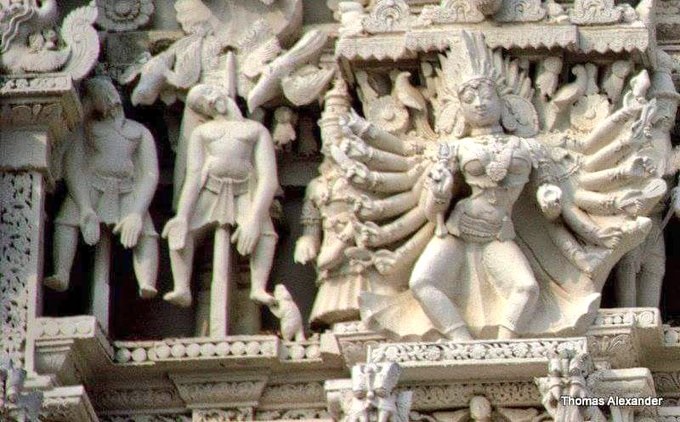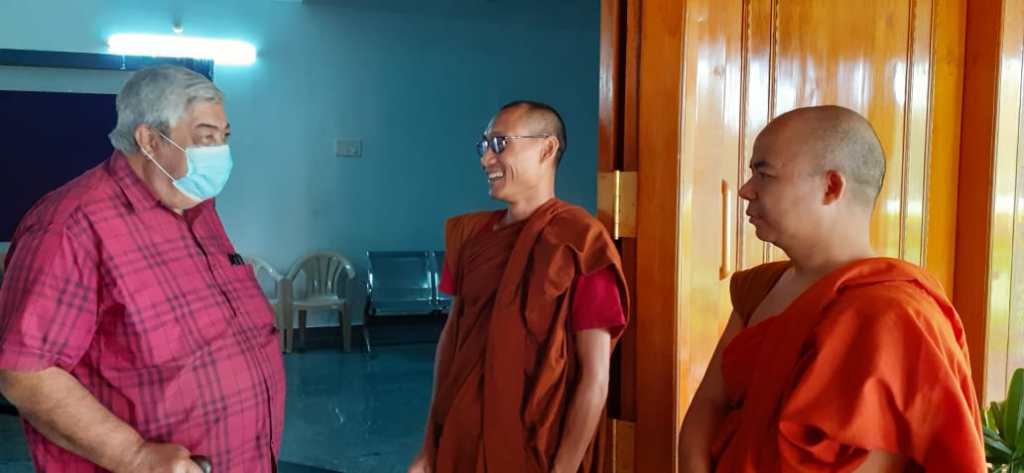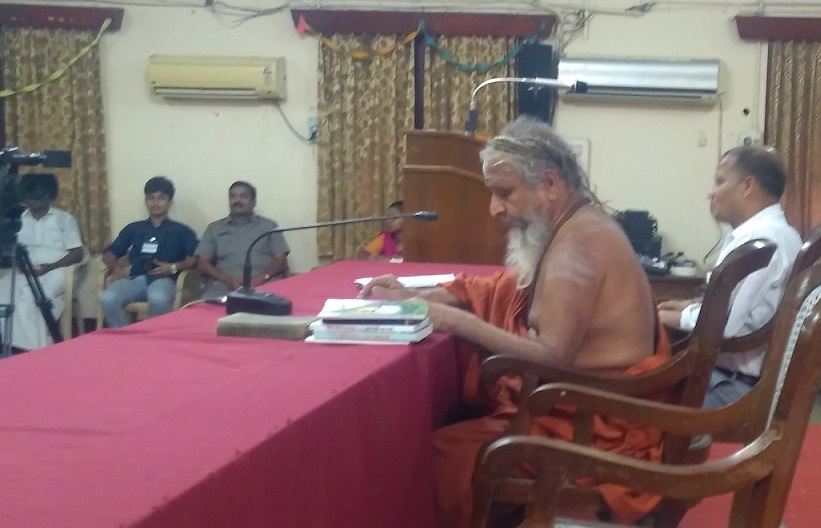The proceedings of the National seminar Buddhism and Sectarian Religious faith in India or Buddha and Anti-caste Bhakti Saints held at Acharya Nagarjuna University on March 1st and 2nd 2023 (3)

01-03-2023 (Wednesday) – afternoon session: Afternoon, the second session, the following papers were presented:
| Speaker / paper presenter | Title of the paper | Page no. |
| P. D. Satya Paul[1] | Title – not known, not listed / included in the “Abstracts” He spoke twice for nearly two hours…. | ? |
| K. V. Ramakrishna Rao[2] | The Sectarian encounters between the Buddhist and Jain faiths during the Medieval period for commercialization and communalization | 34-35 |

P. D. Satya Paul delved upon the communal Hinduism criticizing P.V. Kane who carried on the Maxmueller’s project, Dr S. Radhakrishan for his opinion about Buddha (Buddha’s movement was a protestant type of reformative Hinduism) and Swami Vivekananda for perpetuating caste. He was suggesting about a “proto-sramanic” tradition before IVC, based on which, the Buddhism could have been evolved.

Getting ready for power-point…..

K. V. Ramakrishna Rao presented his paper, “The Sectarian encounters between the Buddhist and Jain faiths during the Medieval period for commercialization and communalization,” based on the medieval inscriptions, sculptures, paintings and literature. The question of “Himsa and Ahimsa” (violence and non-violence), karma, atma, rebirth etc., the following issues were discussed:
- Why Jainism and Buddhism flourished before and after the “golden period” of the Guptas?:
- What happened between the Arab / Mohammedan invasion and European intrusion during the 12th to 16th centuries?:
- The impact of the Europeans on the Jains and Buddhists during the medieval period
- The psychology of Non-violence and violence
- A Dispute between the Mahayana Buddhists and Digambar Jains over Mt Girnar (Gujarat), where all sectarian groups had encounters
- Internal and inherent factors are also responsible for the decline of Jainism and Buddhism
- Transition of faiths in Andhradesa and clash of faiths
- The Jaina-Buddhist conflicts in Karnataka and Tamilagam
- Ahimsavadis – Jains and Buddhists eating flesh
- Vegetarianism, non-vegetarianism and Jaina-Buddha dynasties
- Rivalry among the Business men and Priests
- Dynasties following sectarian faiths and their transition
- Sectarian faiths made talented workers to loose their identity
- Rivalry Among the Jains and Saivites or Sculptors and Agriculturalists?:
- Brahmins versus non-Brahmins
- Sectarian conflicts recorded in the inscriptions
- Oil, oil-mill and their euphemism in Jainism
- Was there any nexus between Jains and extremist groups like Kapalika, Kalamuka etc?:
- Syncretism, eclectism and inculturation
- In-lieu of conclusion – Commercialization and communalization of sectarianism

The Jaina monks that were defeated in the debates were punished based on their agreed condition……

This type of sculptures are found in many temples…….

Then, the following conclusions were drawn:
It could be noted in the most of the sectarian encounters of whatever nature, whether it was philosophical debate, theological polemics, right over property, manufacture and production of goods and services, imports and exports, monopoly of trade route and related issues. Thus, the following features could easily be noted working:
- Commercialization and communalization of sectarianism had been the hallmark of medieval inland and oversea trade and commerce.
- As more and more goods and services had to be manufactured and produced, more labourers, workers and technicians were required for carrying out various assembly, fabrication and construction activities.
- Such experts had to be trained, organized and made to work according the exigencies, emergencies and requirements at national and international obligations.
- Thus, such experts had to be faithful, loyal and obedient to the authority, rulers and government.
- Here, the merchant guilds, trade groups and commercialized communal organizations worked effectively aiding and abetting the rulers.
- Accordingly, most of them had to be polyglots, dubashis, sailors, warriors, pirates and profiteers also.
- Under such compulsions, complexities and commitments, social, political, commercial and maritime set-up, the moral, ethic and code of conduct were relegated to background, operated selectively and sectarianism ruled roost.
- The violators of their own imposed acts and rules were punished, prosecuted and even killed without any mercy, but, all carried on in the name of faith and religion only.
- Finally, syncretism had taken place to accommodate all deities, idols or the defied symbols in the places of worship.

Such depiction is found in the Buddhist paintings also…..

There was a discussion and questions by the Chair and Satya Paul and the paper presenter clarified. They questioned about the mentioning of Chandragupta Maurya, Bindusara and Asoka as grandfather, father and son, but, I do not find any chronological or historical issue in the lineage.

Then, the former HOD of the department, who presided over the session, was facilitated.

Former HOD of the Mahayana Buddhism centre was facilitated.

02-03-2023 (Thursday) – second day proceedings:
| Speaker / paper presenter | Title of the paper | Page no. |
| Yadhava Raghu[3] | Dasa movement and its impact on Telugu villages bordering Karnataka: a case of Pyalakurthy village, Kurnool district[4]. | 37-38 46 |
| John Weasley[5] | Siddha cults in South India. | 57 |
| Sugandha[6] | The Buddhist perspective of social sratification | 5 8 |
| N. Kanakaratnam[7] | Caste revenge on adigas and Malas. | 60 |
| Eluri Harshavardhan[8] | Egalitarian ideals of Buddhism: A repository of counter discourse in Andhradesa | 49 |
About dasa, dasari, dasari caste etc: Dasari is a Vaishnava mendicant caste in Telangana region and Andhra Pradesh, India. They are involved in various business, trades, poojas, marriage rituals, plays and agriculture. Their traditional work is in temple service. They perform death rites in burial grounds as their main occupation. Some of them work as day laborers. They are landless. Some of the Dasari Mala work in business and agriculture. They use both modern and traditional medicines. They are not vegetarians and eat rice as a staple food. The Dasari Mala prefer marriage between cousins. The bereaved and divorced can marry again. The dead are buried rather than cremated like most Hindus. On the death of the father, sons inherit the property with the oldest son taking charge of the family estate. They observe birth and marriage rituals. They are also known as Poosala Balija, Bukka Dasari, and Krishna Balija in different areas of their habitation. However, in Karnataka, how castes with similar sounding names can be mistaken can be noted. In Karnataka, the Dasari caste comes under Category-1 whereas Channa Dasar is SC. Similarly, Bhoyi is Category-1, but Bhovi is SC. Jangama comes under the general category, but Beda Jangama is SC. Therefore, just with the word, “Dasari,” one cannot come to any conclusion. Moreover, the paper readers started with Kanakadasa story and then switched over to the Pyalakurthy village, Kurnool Dist., to claim that the “Dasari caste” people there could be connected with the “dasaris” of Karnataka. Obviously, he is confused with “dasa” of Madhwa tradition, “Dasari” caste and other “Dasari” tradition (being obedient servant / slave.)

These are some of the Tamil Siddhar as found on the temple pillars etc., dated to later medieval and modern periods….
About Siddha, Siddhi, Cittam etc: The seminar brochure claims, “Siddha Tradition in South India was evolved out of Buddhist school of Vajrayana was more prevalent among the lower strata, strived to attain equality in religious sphere. Many Siddha cult centres of present Andhra and Telangana states including Siddhavatam, Siddeswaram, Siddula Guttalu etc. are the live examples for this phenomenon. The medieval text (14-15th CE) in couplet form ‘Navanadha Charitra’ written by Gourana also mentioned about the Siddhas.” It is not known what is the proof to claim that “Siddha Tradition in South India was evolved out of Buddhist school of Vajrayana..,” as the Tamil Siddha tradition has nothing to do with any Buddhism. Taking the word “Siddha”( సిద్ధ), the Telugu scholars, researchers and even historians try to link them with “Siddhar, Siddha medicine” and so on, whereas, the Tamil Siddha (சித்த, சித்தர்) nothing to do with. In the process it attempts to narrate the relationship of places like Mahendragiri (of Srikakulam district, Andhra Pradesh) with sage Agastya (one of the very important Siddhars of Siddha medicine) and possible origins of very old common religion (Siva Siddhanla) propagated by Dakshinamurti, through his four disciples from this place. names like Siddha, Sangam, Nandi which are still used in the same sense as they were used from time immemorial. Without knowing the fundamentals, Tamil language and reading the texts of Tamil Siddhas, they misinterpret taking the words. Many list of the places, cities etc., with “సిద్ధ” in Telugu, go on interpret that all such places are connected with Siddhas since immemorial. Of course, they take the Agastya myth also for strengthening their argument.
© K. V. Ramakrishna Rao
05-03-2023

These are imaginary pictures of 18- Tamil Siddhars…

[1] Department of Anthropology, Andhra University – Visakhapatnam – appears to be involved in Dalit, Christian and related studies.
[2] Guest faculty, University of Madras and Visiting faculty for Annamalai University, Research Scholar, Department of Ancient History and Archaeology, University of Madras, Chennai.
[3] Asst.Prof, History Dept, Sathya SaiUniversity for Human Excellence, Kalaburagi, Karnataka.
[4] His paper has been printed twice as shown – this shows the mechanical way of preparation of “Abstracts” without going into the details.
[5] Research scholar, Centre for Mahayana Buddhist Studies, ANU, AP.
[6] Research scholar, Centre for Mahayana Buddhist Studies, ANU, AP.
[7] Professor, History, Kakatiya University, Warangal, Telangana.
[8] Dept. of History and Archaeology, Dravidian University, Kuppam, AP.

Filed under: Acharya, Acharya Nagarjuna University, agrarian, agriculture, alloy, ambedkar, anti-brahmin, anti-caste, anti-hindu, anti-india, anti-indian, anti-vedic, Ariyar, Art and Culture of Tamil Nadu, Aryan, ascetic, ash, ash mound, ashmound, myth, mythologization, mythology, Nagarjuna, Nagarjuna University, neolithic, nomad, non-brahmin, non-Veddc, non-Vedic, non-vegetarian, non-violence, not Hindu, P. D. Satya Paul, pashvanatha, periyar, periyar philosophy, praccana buddha, proof, psychology, race, racialism, racism, reality, rebirth, rebuttal, reform, reformation, refutation, relic, Rigveda, Saiva, Saiva Siddhanta, Saivam, Saivism, Samani, Samskara, Sanatana, Sanatana freligion, Sangam, sangam, Sangam literature, sangam literature, sangam period, Sanskrit, sanskrit, sanskrit language, SC, scheduled caste, scheduled tribe, sectarian, sectarian faith, sectarianism, sex, sexploitation, siddha, Siddhanta, siddhar, slave, slavery, sloganeering, social justice, social reform, Social Reform Movement, Social Reform Movement In India, social reformation, spirit, spiritual, spirituality, suppressed, suppression, sutra, tamil, tamil chauvinism, Tamil inscription, Tamil manuscript, Tamil manuscripts, tamil sectarianism, tamil separatism, tamil siddha, Tamil siddha manuscript, Tamil siddhar, tamilnadu, temple, temple attack, temple demolition, temple desecration, theistic, third gender, tirtankara, tradition, transgender, tribal, uncivilized, upanishads, Uplift of women, Upliftment of Dalits, Veda, vedanga jyotisha, Vedas, Vedic, vegetarian, violence, vivekananda, vyasa, wahabi, Wahabi conspiracy, wahabi movement, wheel, woman, women, women education, xenophobia, Yogic, Yogini, young, youth | Tagged: acharya nagarjuna, Acharya Nagarjuna University, anti-brahman, anti-brahmin, anti-caste, anti-hindu, anti-sanskrit, arya, aryabhata, aryan, aryan invasion, aryan race, bhagavadgita, bhagawat gita, bhakti, bhakti movement, brahmin virus, brahminical diaspora virus, buddha, buddhism, Buddhist, buddhist claim, buddhist site, carona virus, caste, caste conflict, caste politics, caste virus, casteism, dalit Jain, Dramila, dravid, Dravida, Dravidam, Dravidar, Dravidi, Dravidian, dravidian model, dravidian race, dravidian stock, jain, Jaina, jainism, khastriyaism, non-vegetarian, P. D. Satya Paul, scheduled caste, sect, sectarian, sectarian conflict, sectarian violence, sectarianism, sudraism, vaisyaism, vegetarian, virus | Leave a comment »
































